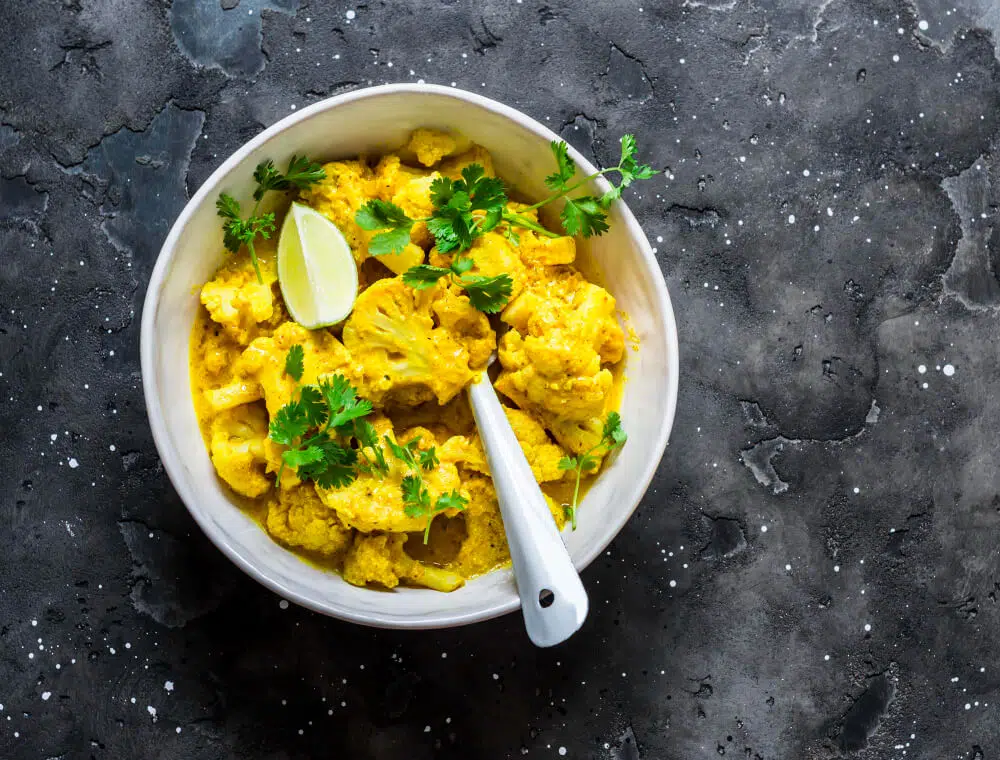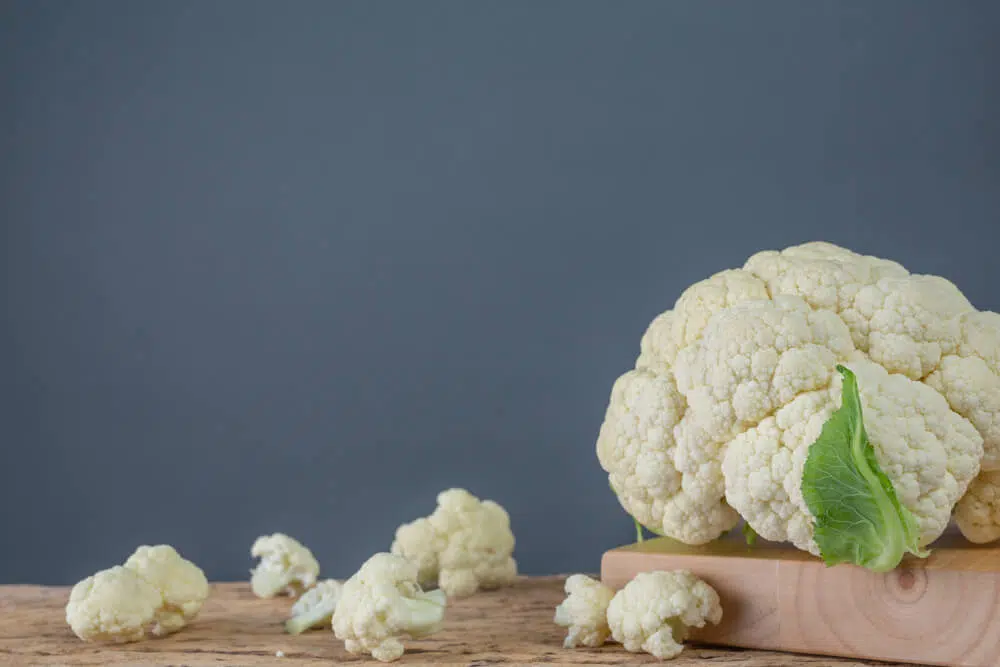Home » Cauliflower Keto Curry

Carbs
(Keto Carbs) 8g*
Fat
27g
Protein
17g
This lovely creamy curry is based on an Indian vegetarian curry which traditionally contains chickpeas. Since you can’t have those on keto, we came up with this version that’s low in carbs and rich in the good fats. For the non-ketonians at your table, you can serve a bit of rice on the side, but it’s so rich and thick in texture that you can easily enjoy it just by itself as well
The importance of veggies on keto
Some people believe that going keto means living on bacon and eggs (and the occasional avocado). They assume that vegetables are a no-go because most vegetables contain high amounts of carbs and fibre. Don’t worry, it’s nothing like this. Vegetables like those from the cabbage family and other leafy greens are essential to a healthy lifestyle and crucial to succeed on the ketogenic diet, as you’ll read below.
Dietary fibre and carb load
We all know that reducing your carb intake to around 5% of your daily energy intake is at the core of the keto diet. It’s important to understand that fibres don’t count as carbs for your keto diet, even if they are technically called carbohydrates, because your body can’t break them down into digestible sugar molecules. This means that the amount of net carbs (or ‘keto carbs’, as we call them at Go-Keto) of most veggies is much lower than you might think. And since veggies help you feel full and provide your body with tons of essential vitamins, minerals and other micronutrients like antioxidants, they really are key components in every keto diet.
Keto veggies: the top 10 Some vegetables contain more carbs than others. Here’s a to 10 of the most suitable veggies for ketonians that you can eat to your heart’s content:
- Broccoli
- Kale
- Bok Choy
- Cauliflower
- Chard
- White cabbage
- Sprouts
- Asparagus
- Bell peppers
- Zucchini
The superpower of cauliflower
Cauliflower is one of the vegetables that should not be missing from your keto diet. It’s a great source of healthy fibre and it’s packed with vitamins and minerals, especially vitamin C, vitamin K, vitamin B, proteins, magnesium, folic acid and antioxidants. On top of it all, this veggie is pretty low carb, which makes it a perfect source of good keto food. There’s so much good stuff you can make with cauliflower, like soup, curry, or puree, or you can simply fry it with other lovely keto friendly vegetables. This Cauliflower Keto Curry recipe is a great place to start your keto cauliflower adventure!
Ghee: great choice for frying
Some of the best cooks in the world swear by the use of ghee for baking instead of butter. Here’s why: ghee has a much higher smoke point than butter, so it doesn’t burn as quickly. The flavour of ghee fits great with savoury, or sweet-and-savoury foods, but it can be used in almost any recipe. In some ways, it’s a healthier choice than butter – a fine source of healthy fats with an extra high dose of the fat-soluble vitamins A, D, K and E. Plus, it does not contain lactose, so Go-Keto’s Organic Ghee is the perfect alternative for butter or oil that will help you put a lovely lactose-free keto dish on the table in no time!
Serves: 4
Ingredients
- 1 small cauliflower, in florets (you can use the leaves as well, if they’re fresh)
- 1 small onion, chopped (about 80gr)
- 160gr pumpkin in cubes
- 4 eggs, hard-boiled and quartered
- 2 cloves of garlic, chopped
- 200gr full-fat coconut cream
- 500ml vegetable or chicken broth
- Go-Keto Bio Ghee or live oil for frying
- 2 tblsp (Massala) curry powder
- ½ tblsp paprika powder
- ½ tblsp cumin powder
- ½ tsp ground ginger
- 1 tblsp lemon juice
- 1 cucumber, sliced
- Fresh mint or cilantro, choppe
- 30 min
Preparation
- Heat the ghee or oil in a large pan and stir fry the onion and the vegetables, except the cucumber, at medium temperature for about 5 minutes.
- Add the garlic and the spices and fry the mixture for 1-2 minutes. Lower the heat and keep stirring to avoid blackening. If you like your curry hot, add some chili powder as well. (I also like to add some tomato puree for a tiny bit of sweetness, but it heightens the carbs…).
- Add the coconut cream and stir in the broth until the vegetables are almost covered. Bring to the boil, then turn down the heat and allow the curry to simmer for about 20 minutes, until the vegetables are tender. Stir now and then and add some more broth if the mixture gets too dry
- The texture should be pleasantly thick at this point. If you feel it’s too thin, turn up the heat until it’s reduced to the desired thickness. Add lemon juice to taste and season with salt and pepper.
- Serve sprinkled with the chopped herbs and the eggs on top, dusted with some paprika powder and cucumber slices on the side.
*) These are the ‘Keto’ carbs that raise blood sugar. The number does not include the fibres which are technically carbohydrates but do not affect glucose levels.





